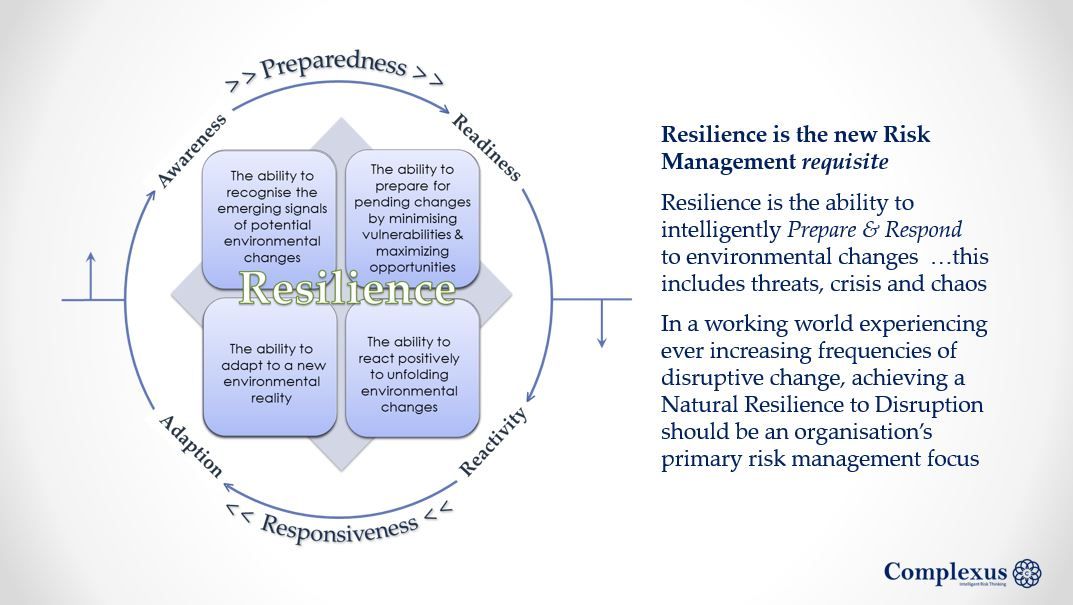I wouldn’t call myself a “nature girl” by any stretch of the imagination. I’m too accustomed to creature comforts – you know, things like hot water, air conditioning, and a soft bed among other things.
However, that doesn’t mean I don’t appreciate the beauty or other benefits nature provides us.
Therefore, when I stumbled upon Warren Black’s Risk 4.0 vlog on examples of resiliency in nature and how organizations can apply them, I was naturally (…no pun intended) intrigued.
While “resiliency” may seem like one of those overused corporate buzzwords like core competencies, ecosystem, black swan, or gray rhino, it is important nonetheless, especially in its relationship to risk management.
Being the buzzword that it is, there are many definitions of resiliency floating around out there. The one Warren believes captures the concept is grounded in natural complex systems, which defines resiliency as:
…the ability of a natural system to intelligently prepare to and respond to environmental changes, including threats, crisis, and chaos.
As Warren explains at the beginning of his presentation, COVID brought resiliency to the forefront, and in his opinion, changed what the ultimate goal of risk management should be. Rather than identifying, quantifying, and prioritizing threats and creating mitigations or some other response to address them, risk management needs to adapt to build “resilience” to any type of disruption regardless of likelihood, impacts, or other parameters.
Thankfully, this doesn’t mean we have to reinvent the wheel.
Risk and resilience consultant Gareth Byatt, who was kind enough to share insights for helping companies improve resiliency with me personally, explains in this article published in Enterprise Risk Magazine:
Many tools and techniques that we apply to identifying, assessing, and managing risk lend themselves to purposeful organizational resilience – together with other management techniques that we can add to our toolkit.
Below is a screenshot from Warren that lists and defines four characteristics of resiliency found in the natural world.

The natural world is replete with examples of resiliency. My first foray into this topic used a mighty, 200-year old heritage live oak on my home’s property to illustrate resiliency. Warren provides other great examples based on these four characteristics. These include:
- Awareness – with predators and other threats always lurking, many animals have to be hyper-aware of their surroundings in order to survive. Any time they let down their guard could spell doom. Meercats are one example of hyper-aware creatures that are constantly scanning the horizon for threats and communicating information in real-time.
- Readiness – this can include any creatures that are responsive to change and focused on preparations. They are extremely aware of vulnerabilities and windows of opportunity for addressing them. Examples include migratory birds that fly south for the winter, animals that move to higher ground when they sense rain or a potential flood event, or animals that stockpile food for the colder months of the year.
- Reactivity – these creatures are ready to respond at a moment’s notice and have strong backups in place. Examples include armadillos and hedgehogs. At the first signs of trouble, they curl up in a ball. It’s not the change the animals undergo so much as the speed at which they react.
- Adaptation (cornerstone of resilience, in my opinion) – the ability to adapt to changing circumstances. This is especially common in the natural world and part of the lifecycle of many species. Frogs, butterflies, and even humans have adapted to circumstances in order to survive and thrive. Chameleons that change colors is another such example.
In his discussion of each of these characteristics, Warren also provides examples from well-known brands like Encyclopedia Britannica, Kodak, Tylenol, and Apple that either succumbed to disruption or overcame it and continue to thrive to this day.
Therefore, I highly recommend watching the entire session — it will be 20 minutes well spent.
These characteristics can be a framework for helping an organization achieve resilience. It’s increasingly important for organizations to understand how they can be disrupted and take steps to build resilience to that.
Warren explains that this must be a, if not the, top priority of ERM going forward.
Because let’s face it – if some of the world’s most long-standing, iconic brands can be disrupted and become history, so too can your organization.
What other animals or natural processes can we look to as examples of resilience? Are there other ways businesses can mimic nature to ensure their long-term survival?
I’m interested in hearing your thoughts on this exciting topic…please don’t hesitate to leave a comment below.
And if your company is concerned about disruption and struggling to find ways to prepare, much less benefit from it, please feel free to reach out to me today to begin discussing your challenge(s) and potential solution(s)!
Featured image courtesy of Niklas Hamman








